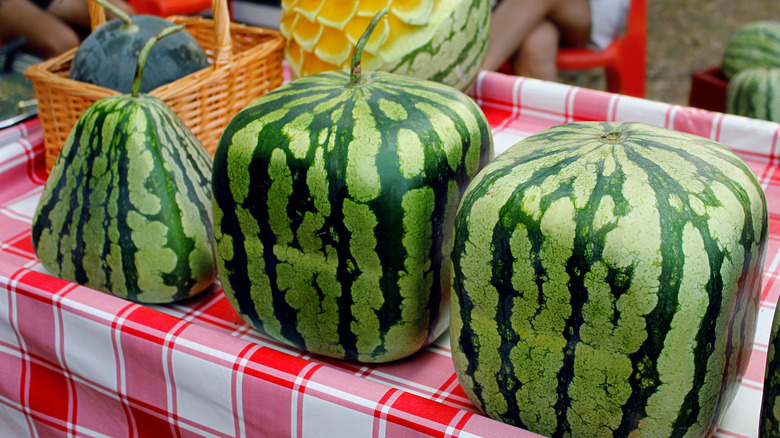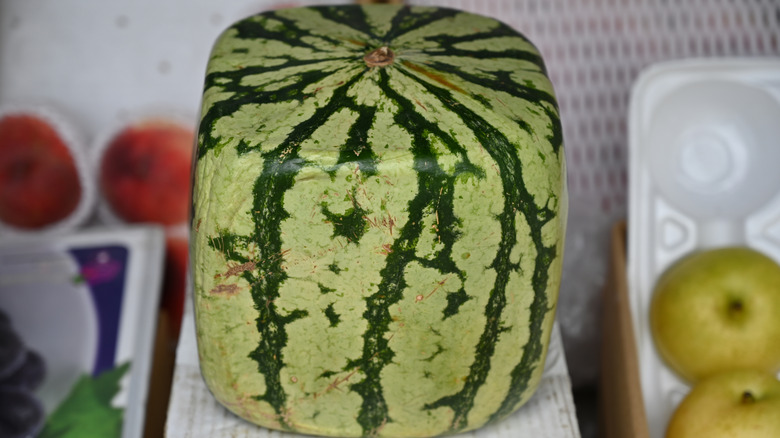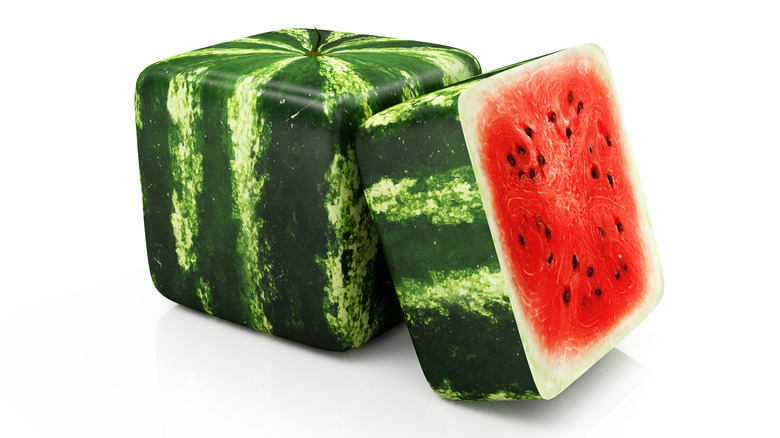The Expensive Square Watermelons You'll Only Find In Japan
Japan is known for having a certain fondness for luxurious fruits, from the Crown Melon, which looks like a cantaloupe and retails for $200 per melon, to the much sought-after white strawberries of Karatsu City. This is in large part due to a gifting culture in Japan wherein beautiful specialty fruits or other presents are purchased to show respect when visiting family or colleagues, and extravagant prices are merely seen as proof that you're really trying to demonstrate your gratitude.
But among these unconventional pieces of produce is one that has gained a lot of interest internationally: the square watermelon. This marvelous specimen looks like something out of a cartoon or video game, a gleaming green-striped cube with soft, rounded edges. In Japan, where square watermelons are grown, they can sell for the U.S. equivalent of more than $100, which is why they are more often purchased as gifts than as a refreshing everyday snack. Unfortunately, if you want to get your hands on one, you'll have to import one or visit Japan: They are exclusive to the island nation.
How do you get square watermelons?
Known as Shikaku suika in Japanese, these square watermelons were developed in the 1970s by an artist named Tomoyuki Ono in the Kagawa prefecture, specifically the city of Zentusji. Part of the goal in making these watermelons wasn't only aesthetic but practical. Not only are they easier to pack and ship to market, but they are also conveniently shaped to fit in your refrigerator. Plus, as you'd imagine, they are way easier to cut than a slippery round watermelon.
Despite their fascinating shape, square watermelons are actually not that difficult to grow. In fact, you could grow one in your own backyard. All you need to do is fit the watermelon in a transparent box frame when it is small, with a hole cut out for the stem, and it will grow to fit the mold. These can be made of glass or strong plastic, so long as the fruit has access to sunlight inside the mold.
Sure, that might sound like a lot of extra work. But it's sure cheaper than importing them from Japan for at least a hundred dollars a pop!
You don't want a slice of this watermelon
However, while watermelon might be best known as a handy source of natural refreshment on a hot summer day, these square watermelons from Japan actually aren't generally meant to be eaten ... And if you did try to have a slice, you would likely be sorely disappointed. These melons are often picked just before they have fully matured, so they aren't particularly tasty.
Instead, square watermelons are often used for decorative purposes and might be purchased by department stores or hotels as part of a window display or elaborate lobby decor. As anyone who's familiar with produce will know, the more ripe a fruit, the less time it has before it becomes overripe and soft. Picking not-yet-ripe square watermelons allows them to survive for longer as decorative objects, which is frankly probably what you're looking for if you've paid a couple hundred dollars for the privilege of owning one. So if you see one on display, don't try the two-finger trick for sweeter melons; square watermelons will be pithy and not sweet, alas.



